Last Chance to Catch NYC's Holiday Notalgia Train
We met the voices of the NYC subway on our nostalgia ride this weekend!



Photograph by James and Karla Murray
Jamaica, Queens has a rich history spanning before the formation of the United States. Named after the Jameco Indians who originally occupied the area, in the 1650s, 15 English families obtained a charter from Peter Stuyvesant to settle in Rustdorp (“rest-town”), which is what the Dutch called Jamaica. After the Revolutionary War, Jamaica was the first village in Queens County to become part of the United States.
In the late 20th century, business declined in Jamaica when big companies moved to suburban areas where it was more profitable, and the crime rate increased crime because of the crack epidemic in the ’80s. But, in recent years, a revitalized Jamaica has seen a boom in business and culture, with plenty of iconic historical places to visit, while offering up exciting new places to check out. Here’s our Untapped Cities guide to the Queens neighborhood.
Prospect Cemetery, located on what is now 159th Street and Beaver Road, was the graveyard used by the early settlers of Jamaica, and is the fourth-oldest colonial cemetery in the five boroughs, and is a designated New York City landmark and on the National Register of Historic Places.
Amongst the buried are 53 Revolutionary War veterans, 43 Civil War veterans, three Spanish-American War veterans, and a number of prominent families with surnames like Van Wyck, Sutphin, and Brinkerhoff. Also in the cemetery is the Chapel of the Sisters, which was added to the cemetery in 1856 by Nicholas Ludlum who bought the land to be used as a memorial to his three daughters who died young.
Despite the segregation of graveyards, one black woman by the name of Jane Lyons was buried here. Her tombstone reads, “Jane Lyons, a colored woman, who upwards of 65 years was a faithful and devoted domestic in the family of James Hariman, Sr., of this village, died December 19, 1858. Age 75 years.”
Efforts to revitalize the cemetery began in 1999 with the Prospect Cemetery Revitalization Initiative, dedicated to beautifying the cemetery, and it is spearheaded by the Prospect Cemetery Association of Jamaica Village. The President, Cate Ludlam, is a descendant of Nicholas Ludlum, and the association is comprised of descendants of those buried in the cemetery.
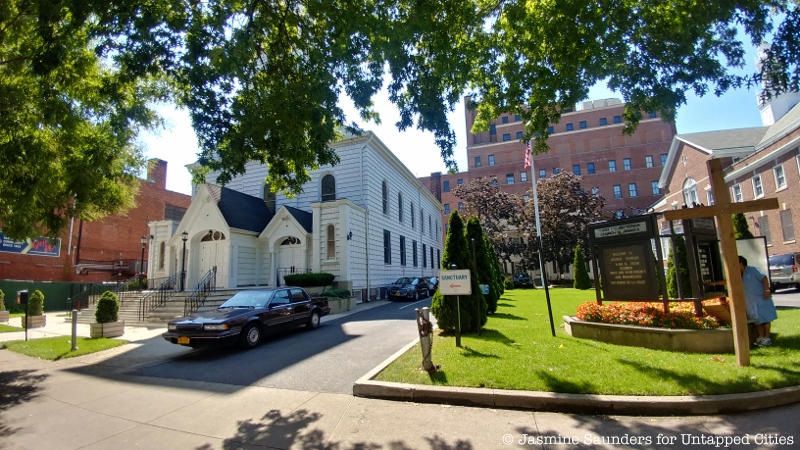
The First Presbyterian Church of Jamaica is the oldest continuously serving Presbyterian church in the United States under three flags: the Dutch, the English and the United States. The church was founded in 1662 when the area was the New Netherlands settlement of Rustdorp.
In 1699, villagers built a 40 foot stone building on what is now Jamiaca Avenue, until it is replaced by the current building in 1813. Over a century late, the church was places on logs and moved to its present location at 164th Street, right off of Jamaica Avenue. In 1962, the church expanded to include the Magill House, providing the church with an auditorium, gymnasium, library, classrooms, and recreation centers.
Despite its heritage, the church is not listed on the National Register of Historic Places due to the current Reverend Patrick O’Connor’s decision because of the restrictions that come with altering a building once it’s been listed.
Today, the church continues to be a place of worship to the residents of Jamaica, expanding its outreach through programs like Girl and Boy Scouts, soup kitchen, distribution of food items, Bible Study, athletics, recreational activities, tutoring, and more.
You can find the church at 89-60 164th Street.
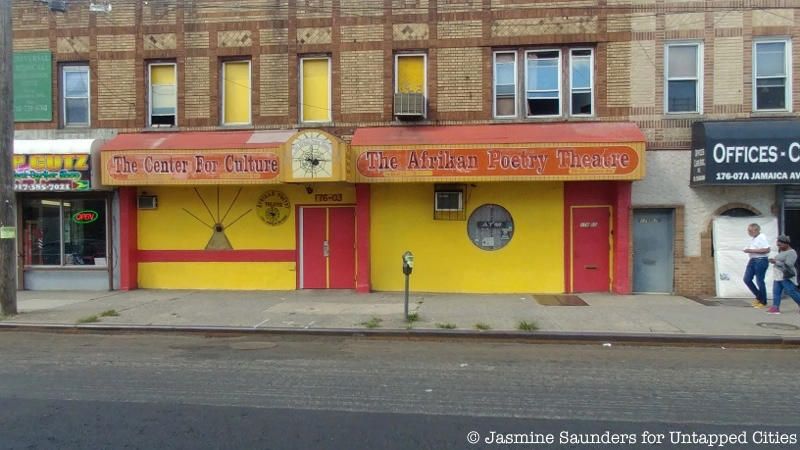
The Afrikan Poetry Theatre was established in 1976 by John Watusi Branch, a well-respected and known figure in the Pan-African Movement, and Yusef Waliyaya. For 40 years, this theater continues to serve its predominately African American population well with various programs and events that cater to different interests.
The theater offers acting classes, partners with other arts organizations for dynamic poetry slams, open-mics, art exhibitions, live bands and more. The theater even hosts Kwanzaa celebrations and presentations. If you’re ever in Jamaica area, come by the Afrikan Poetry Theatre. You’re bound to learn something and enjoy it too!
The African Poetry Theatre is located at 17603 Jamaica Avenue.
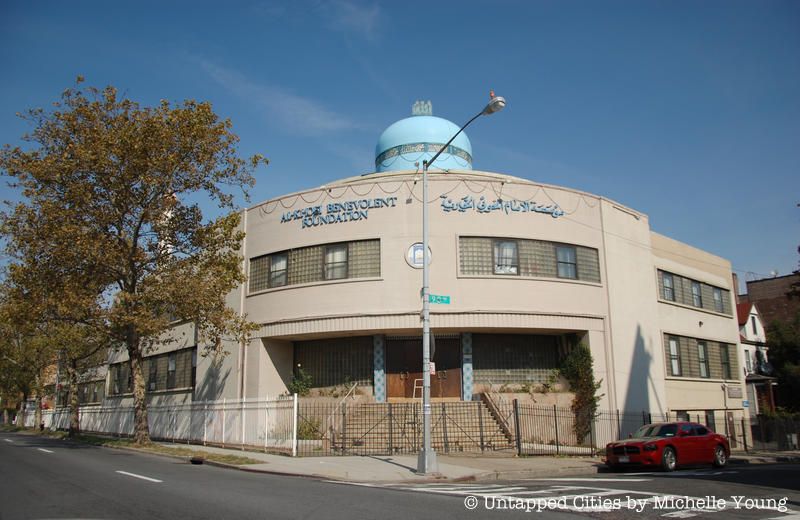
Located along the Van Wyck Expressway, across from the Jamaica Hospital stands the Imam Al-Khoei Benevolent Foundation. Converted from an old factory built in 1945, it is the New York headquarters for the Benevolent Foundation, an “international, religious, charitable institution established by the Late Ayatullah Seyyid Abulqasim Al-Khoei,” since 1989. The building contains a prayer hall, library, community center, school, and the iman’s apartment.
While we haven’t been able to figure out what type of factory the building was, it doesn’t look to be any kind of hard industry especially given its location. It is also unclear whether there was a period of vacancy or not before the land was purchased by the Benevolent Foundation.
Find the factory turned mosque at 89-89 Van Wyck Express Way.
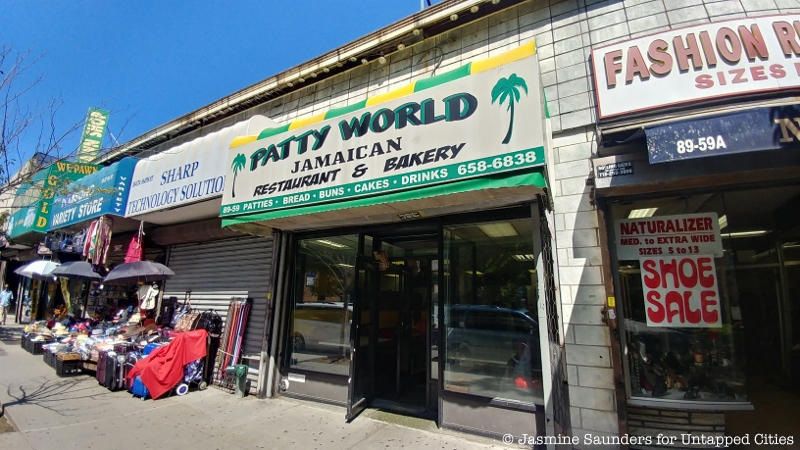
While Patty World is not a lavish establishment, it’s still a pretty great spot for delicious Caribbean cuisine. Located on 164th Street off of Jamaica Avenue (right across the street from the First Presbyterian Church of Jamaica), the place serves Caribbean favorites from beef and chicken patties to customer favorites such as oxtails and jerk chicken.
Prepared with intricate Jamaican spices and in jerk style, the food from this place is a delicacy and is raved about amongst the community. Note that Google says restaurant has relocated, but it’s still open and serving great food at its original location.
Patty World is located at 8959 164th Street.
The Beijing Dumpling House, while serving a wide variety of Chinese food, is most famous for the dish in its name: dumplings! Whether boiled or fried, they are packed full of flavor from the various ingredients inside like pork, chives, and shrimp, including a vegetarian option.
The next delectable item on the menu are the homemade noodles, combined with flavorful spices served dry or in soup that keep people coming back. It’s location near the Sutphin courthouse, so if you happen to be serving jury duty, stop here for a good bite. With a welcoming atmosphere, the staff takes great pride in the cuisine they create, and they even deliver.
The Beijing Dumpling House is located at 88-38 Sutphin Blvd.
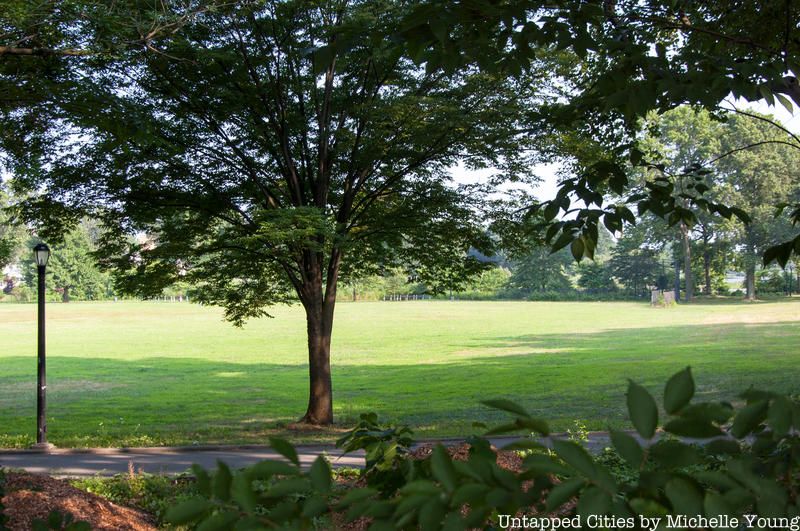
Baisley Pond Park, named after farmer David Baisley, owned the land in the early and mid-nineteenth century, operating a grain mill near the pond that was created a century before as a source for power. The Baisleys lived there until the death of David’s wife Sarah in 1878 (note: the family is buried in Prospect Cemetery.)
The land was sold before David’s death in 1875 to the Williamsburg Water Works Company for $26,000 to be used a water source for Brooklyn. New York City transferred the northern part of the park to the NYC Parks Department in 1914, and five years later it opened to the public. Today, the park is a gem of Jamaica where people can come enjoy the abundant nature, jog, bike ride, and lounge on the lush grass in the cool shade, and can play tennis or handball among other activities.
A fun fact about the park: the remains of an American mastodon were found on the grounds in 1800. A statue was erected to symbolize the discovery and stands in Sutphin Playground to this day.
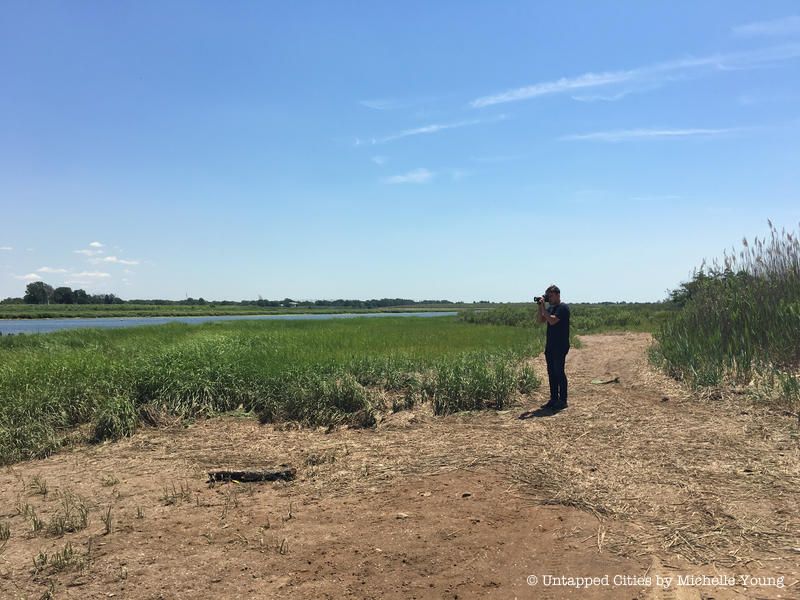
The Jamaica Bay Wildlife Refuge is the only wildlife refuge of the United States Department of the Interior administered by the National Park Service. All other national wildlife refuges are under the supervision of United States Fish and Wildlife Service.
The Jamaica Bay Wildlife Refuge is 9,000 acres of saltmarsh, open bay, mudflats, upland field and wood, two man-made brackish ponds, and small fresh water ponds. Located on the Jamaica Bay, the wildlife is abundant and is one of the best places in New York City to observe migrating species with 332 bird species sighted over the last 25 years. The best times to visit are during the Spring and Fall Migrations where you can watch birds like the Yellow-crowned Night-Heron and the American Woodcock as well as several others.
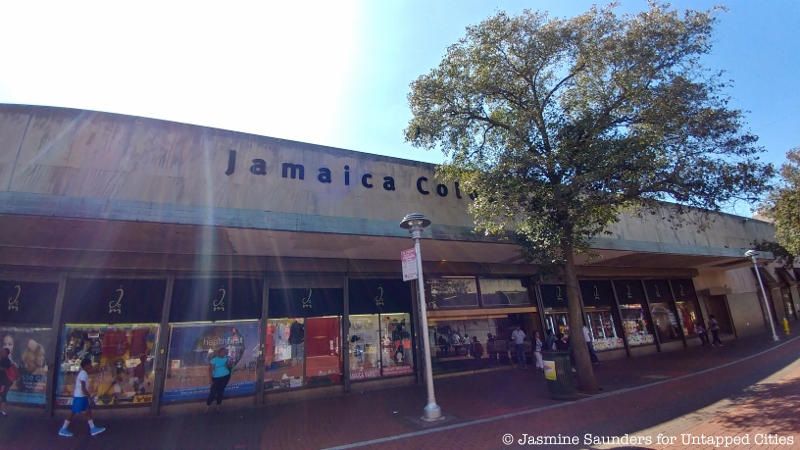
Jamaica Colosseum Mall’s 165th Street side
The Jamaica Colosseum Mall (JCM) is one of the largest jewelry exchanges in New York City. It was founded in 1984 and serves as a major retail hub in the community. The name comes from the Roman Colosseum where merchants sold their good to the public. In addition to Jamaica Avenue, JCM is a large retail outlet home to many shops known for selling jewelry and clothes.
When businesses in Jamaica were being abandoned in the 1970s, JCM helped to revitalize the economy of the area and restore its history as a shopping hotspot. Part of the JCM’s history are the famous musicians who grew up in Jamaica and shopped in there like LL Cool J, the Wu-Tang Clan, 50 Cent, Run-DMC, and Jay-Z. The two former even shot music videos in the mall. This mall is definitely on the map and keeps its finger on the pulse of the community by providing fresh gear to ensure that you’re always popping.
If you’re looking for even more shopping in the area, check out the 165th Street mini mall near JCM right off Jamaica Avenue. It’s another shopping hub with vendors offering various items and services like clothing, footwear and hair braiding, as well as food shops.
Find the JCM at 89-02 165th Street.
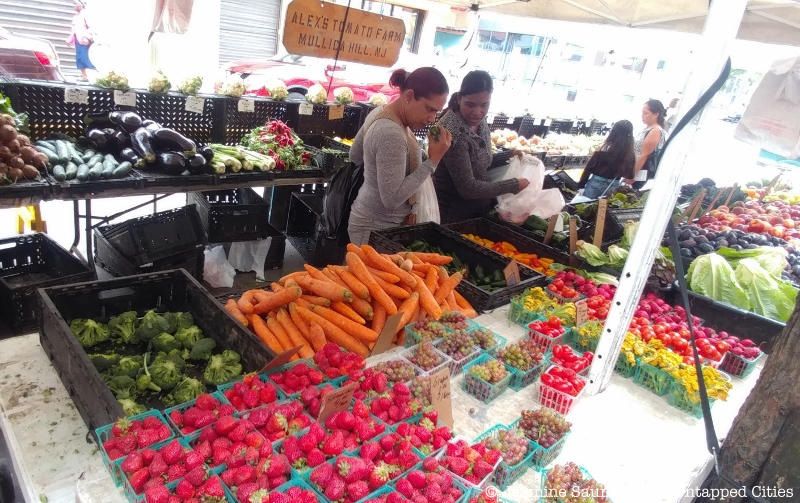
The Jamaica Farmers’ Market is the brainchild of the Greater Jamaica Development Corporation and Down to Earth Markets, is the longest-running in New York City, opening for its 43rd season this past summer.
The market is seasonal and is open on Fridays and Saturdays primarily from June to November. It features local vendors such as Alex’s Tomato Farm, Gajeski Produce, Meredith’s Country Bakery, and Migliorelli Farm that offer fresh produce and foods made from ingredients all over the state. On Fridays, the market is located on Parson’s Boulevard between Archer and Jamaica Avenues. On Saturdays, it’s located on 160th Street between Jamaica and 90th Avenues.
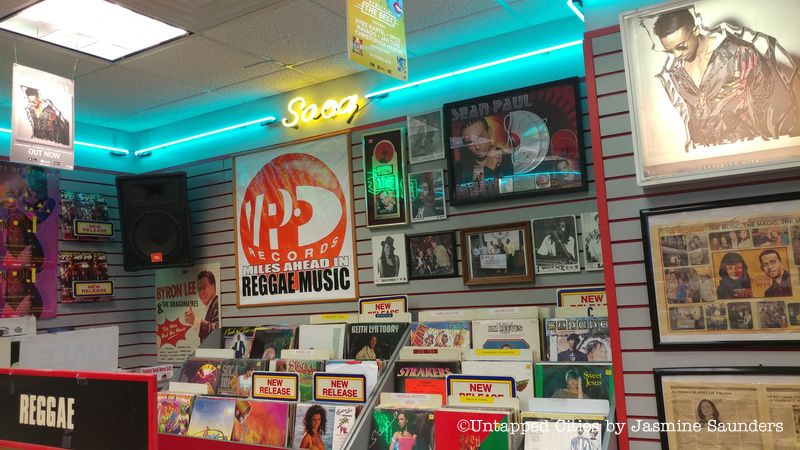
VP Records is one of the largest independent reggae labels in Jamaica. Founded by Vincent “Randy” and Patricia “Pat” Chin, immigrants from Kingston, Jamaica who moved to New York to achieve their American Dream. They opened VP Records in 1979, an internationally renowned reggae and Caribbean music label and distributor, to fill the void for the genre as it was largely unknown to the city at the time.
“A lot of the music stores are no longer around, but the VP Records retail outlet continues to serve the community with new releases and vinyl classics,” said Pat in an interview with the Jamaica Observer. Her husband Vincent, a record producer and label owner, passed away in 2003, but the vibrant shop continues his legacy. Today, the label is run by the Chins’ sons Randy and Christopher, with Pat maintaining the company as well.
Visit their retail store at 170-21 Jamaica Avenue.

Located on Jamaica Avenue and 150th Street, the King Manor Museum is part of historic Jamaica because it used to be the house of Rufus King, one of the signers of the United States Constitution. King and his family moved to the manor in 1806 after he served as the US Ambassador to England following the Revolutionary War. The Georgian-style house was built in the 1750s and was bought by King from its previous owner, Christopher Smith in 1805.
The King Manor was the home for the family for decades until King’s granddaughter Cornelia King died in 1896. The house then became the property of the City of Jamaica.
The King Manor Association, established in 1900, cared for the manor and collected the historical artifacts of the family, and when the house was restored in 1965 by the City of New York, the Association oversaw the process. The manor was added to the National Register of Historic Places in 1979. It has since become a museum open to the public, showcasing the history of the King family and the historical roots of the surrounding Jamaica area.
King Manor Museum is located at 150-03 Jamaica Avenue.
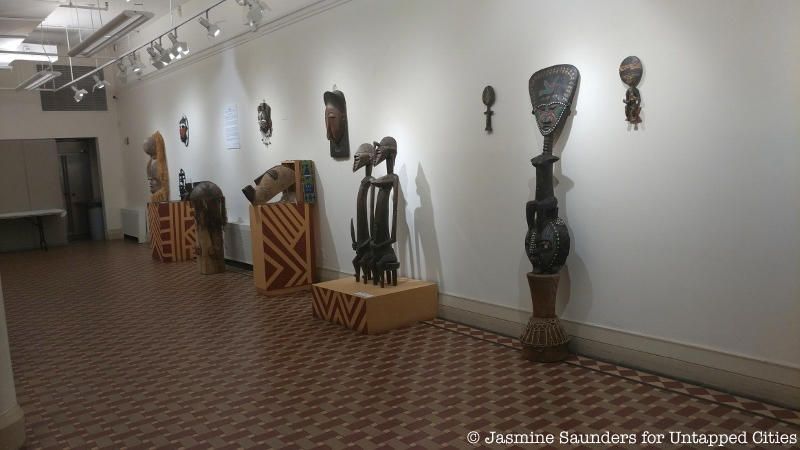
Inside the JCAL Museum
In 1967, a group of local artists, business leaders, and community members came together to revitalize Jamaica. The Jamaica Center for Arts and Learning (JCAL) was a part of that process, its main focus being to bring cultural opportunities to residents of the area that were otherwise limited.
The Center is housed in the once abandoned Queens Registrar of Titles and Deeds Building, which is a registered landmark, and was turned it into a cultural center that inspires the youth to become more interested in the arts through the implementation of various Youth and Family Programs. JCAL also supports the ventures of artists with residencies in the area year-round. There is always something new happening in the Center, so don’t miss it!
Visit the JCAL at 161-4 Jamaica Avenue.

St. Monica’s Church was built in 1856 by master mason Anders Peterson in the Romanesque-Revivial style as the former Roman Catholic parish in the Diocese of Brooklyn, despite its location on 160th Street in Queens. The tall, central campanile in the front is its most prominent feature with an Italian flair. Today, the buildings maintains its historic facade, while the rear has been renovated to a more modern structure.
In the 20th century, much of the area surrounding the church was being bought in the expansion of York College, a part of the City University of New York. The diocese closed the church in 1973 and moved its operations to St. Bonaventure’s on 170th Street. The city then took ownership, but neglected the building subjecting St. Monica’s to vandalism.
The church was marked for demolition until the Friends of Jamaica History and the Queens Borough President’s Office stepped in. St. Monica’s was designed a New York City landmark in 1979, and was listed on the National Register of Historic Places the following year. In a $4.7 million project in 2003, the church became the site for York College’s Child and Family Center which provides affordable and flexible child care for students with children.
Find the old church’s facade at 9420 160th Street.

Photograph by James and Karla Murray
Located on Jamaica Avenue and Merrick Boulevard, Loew’s Valencia Theatre was built in 1929 and was the first of five of the theater company’s “Wonder” theaters. The Loew’s Valencia played movies and held vaudeville performances until 1935 when vaudeville went out of style. Inside the building, the auditorium was Atmospheric and was decorated in a mixture of Spanish Colonial and pre-Colombian styles, and even housed a Robert Morton “Wonder” organ of four Manuals/23 Ranks.
Up until 1960, Loew’s Valencia Theatre was the most successful theater in Queens because of its double feature showings, and its location in Jamaica that was at one time the shopping center for Queens and Long Island. Most importantly, the theater’s shows were debuted at least a week before they hit other theaters in the borough. However, like most of the grand theaters in the city, the Valencia struggled to survive and closed 1977.
In 1979, the building was donated to the Tabernacle of Prayer for All People’s Church and continues to operate under their ownership as a Pentecostal church. The Robert Morton organ was moved to the Balboa Theater in San Diego in 2006, where it was refurbished and debuted the next year. Loew’s Valencia Theatre was added to the National Register of Historic Places and was designated a New York City landmark in 1999.
The theatre is located at 165-11 Jamaica Avenue.
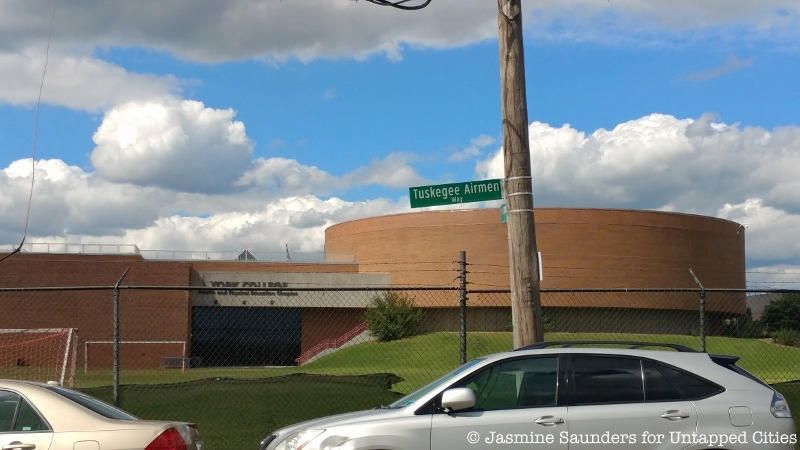
Tuskegee Airmen Way with York College’s Health and Physical Education Complex in the background
Named after the first black servicemen who served as military aviators in the United States armed forces during World War II, the City Council voted unanimously to rename South Road between Merrick Boulevard and Remington Street, Tuskegee Airmen Way, on November 13, 2013. These brave servicemen paved the way for the eventual integration of the armed forces in 1948 under President Harry Truman.
In an article published by QNS, Councilmember Leroy Comrie explained “The Tuskegee Airmen have played an extraordinary part in America’s history and the civil rights movement. By renaming part of South Road Tuskegee Airmen Way, we are helping to ensure future generations of Americans will remember their dedication, and look to them as examples of heroism in the face of extraordinary obstacles.”
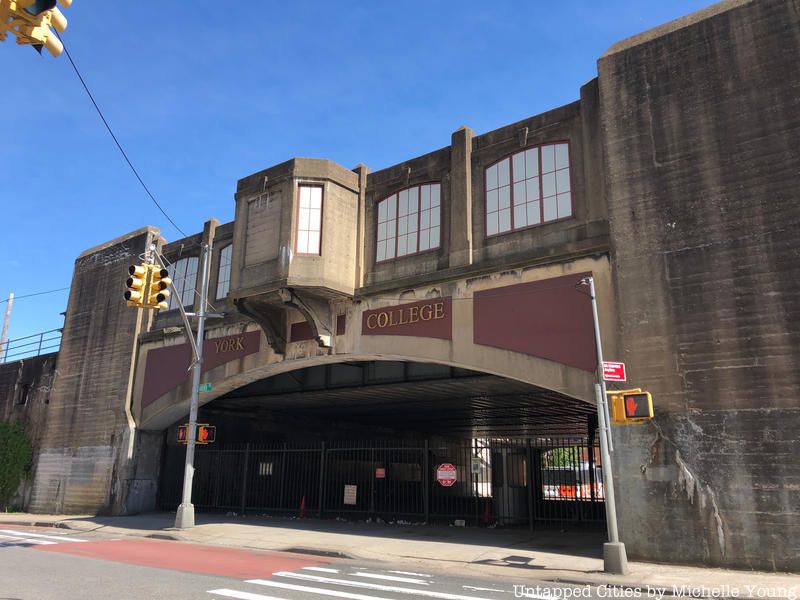 CUNY York College entrance on Union Hall Street and Archer Avenue.
CUNY York College entrance on Union Hall Street and Archer Avenue.
Before the major Jamaica Long Island Rail Road Station was opened, Union Hall Street was a station on a LIRR’s main line. Housed about a half mile east of the current station at Union Hall Street and Archer Avenue, Union Hall Station opened in 1913 as demanded by residents when they heard a new station was being built far from the center of town.
The line was elevated in 1930 as part of the Jamaica East Improvement, but officially closed in 1970. Now, York College campus resides in that space and remnants of the old railroad can still be seen at York’s entrance where the elevated train used to be.
Next, check out our Untapped guides of the neighborhoods of Astoria and Inwood.
Subscribe to our newsletter